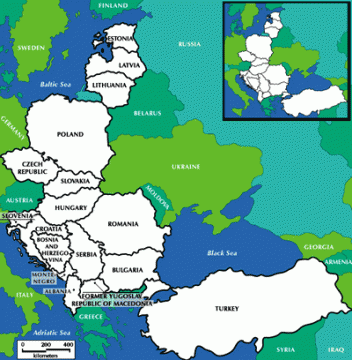Commercial Property Investment volume in Central & Eastern Europe reached €7.4 billion in 2012
 Map of Central and Eastern European countries - CEE Investor focus increasingly on Poland and Russia
Map of Central and Eastern European countries - CEE Investor focus increasingly on Poland and Russia
Despite solid year-end results in Poland and Russia the overall commercial property investment volume in Central & Eastern Europe (CEE) reached €7.4 billion in 2012 - around 35% lower than for 2011.
This is according to the latest data from global property advisor CBRE Group, Inc. (CBRE).
Russia and Poland are increasingly driving CEE volumes, despite decreases of around 20% year-on-year (Y-o-Y) in each market. A clear difference exists between prime assets in the key locations such as Warsaw, Moscow and Prague – where investor interest has remained intact - while the rest of the CEE property market is struggling to attract investors.
Due to the restricted availability of quality retail stock, offices (44% of total volume) have remained the most liquid segment. However, Investors have become more cautious on office investments during 2012. Increased volumes in the industrial sector have confirmed increasing interest in this segment.
Jos Tromp, Head of CEE Research & Consultancy, CBRE, commented:
“Due to high levels of vacancy and relatively low net absorption in recent years, investment in the office segment in Prague has remained low. Prime assets are in demand, however, and are proving difficult to obtain. The purchase of City Green Court by Deka from Skanska for around €54 million confirmed the prime yield levels quoted for Prague. In Warsaw more offices were traded during 2012; however, investors have also started to price in the risk of vacancy increasing over the next 12-18 months.”
Mike Atwell, Head of CEE Capital Markets, CBRE, commented:
“With the pricing of prime office assets relatively stable in most segments and markets, thus far pricing for secondary offices – even in the most liquid cities – has moved by at least 75-100 basis points to date. Some investors have started to show interest for value-add opportunities in prime office locations in order to pro-actively prepare for the anticipated increasing vacancy. The yield gap between prime offices in the capital and regional cities amounts to around 150 bps. Generally the gap between prime and secondary is expected to increase through to the end of 2013.”













